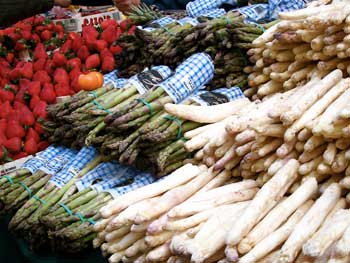 Though you can find asparagus at your supermarket almost all year long, asparagus is actually in season from March until June. Asparagus, a member of the lily family, is quite difficult to grow, causing this tasty treat to be a bit on the pricey side. Asparagus has been used since early on not only as a vegetable to eat, but also for medicinal purposes. Asparagus contains asparagine, a special plant compound, which gives it a diuretic effect, aiding in kidney function. Asparagus varieties include green, white and purple. The white variety is typically milder then the green and the purple can have a subtle fruity flavor. One cup of chopped asparagus has around 30 calories, contains no fat or cholesterol, is low in sodium, and comes chock full of vital nutrients. Asparagus is an excellent source of folate and thiamin (important B vitamins) and is also a good source of fiber, potassium, iron, vitamin C and beta-carotene. The quicker the cooking time, the more flavor the asparagus will have. Their unique taste pairs well with everything from mushrooms to seafood to salads. At your local farmers market, look for bunches that are firm, brightly colored and straight.
Though you can find asparagus at your supermarket almost all year long, asparagus is actually in season from March until June. Asparagus, a member of the lily family, is quite difficult to grow, causing this tasty treat to be a bit on the pricey side. Asparagus has been used since early on not only as a vegetable to eat, but also for medicinal purposes. Asparagus contains asparagine, a special plant compound, which gives it a diuretic effect, aiding in kidney function. Asparagus varieties include green, white and purple. The white variety is typically milder then the green and the purple can have a subtle fruity flavor. One cup of chopped asparagus has around 30 calories, contains no fat or cholesterol, is low in sodium, and comes chock full of vital nutrients. Asparagus is an excellent source of folate and thiamin (important B vitamins) and is also a good source of fiber, potassium, iron, vitamin C and beta-carotene. The quicker the cooking time, the more flavor the asparagus will have. Their unique taste pairs well with everything from mushrooms to seafood to salads. At your local farmers market, look for bunches that are firm, brightly colored and straight.
Creamy Garlic Steamed Asparagus
Prep Time: 5 minutes
Cooking Time: 15 minutes
Yield: about 4 servings
Ingredients:
2 bunches asparagus, rinsed and ends removed
2 cloves minced garlic
2 tablespoons tamari
4 tablespoons tahini
juice of 1/2 lemon
Directions:
1. Place asparagus in a steamer basket.
2. Add about 2 inches of water into the pot.
3. Bring to a boil, cover and let steam for 6-10 minutes.
4. Mix tahini, garlic, and tamari.
5. When asparagus are tender, place in a bowl with garlic mixture.
6. Squeeze with lemon juice, combine and serve.
One of my favorite vegetables! Yum!
——
Healthy eating requires a healthy planet. Check out this awesome program to help preserve the rain forest! http://bit.ly/ryuhT